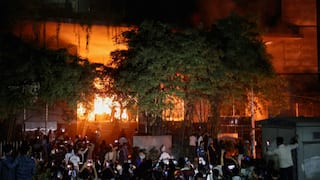Accused Buffalo gunman followed familiar radicalisation path
Buffalo (New York), May 17 (AP): The 18-year-old gunman accused of a deadly racist rampage at a Buffalo supermarket seems to fit an all-too-familiar profile: an aggrieved white man steeped in hate-filled conspiracies online, and inspired by other extremist massacre.

Buffalo (New York), May 17 (AP): The 18-year-old gunman accused of a deadly racist rampage at a Buffalo supermarket seems to fit an all-too-familiar profile: an aggrieved white man steeped in hate-filled conspiracies online, and inspired by other extremist massacres.
Payton Gendron of Conklin, NY, appears to have been driven to action roughly two years from when his radical indoctrination began, showing just how quickly and easily murderous assaults can be spawned on the internet. No tactical training or organisational help required.
While law enforcement officials have grown adept since the Sept 11 attacks at disrupting well-organised plots, they face a much tougher challenge in intercepting self-radicalised young men who absorb racist screed on social media and plot violence on their own.
“That's why everyone is so concerned — and then, if you have a gun, you don't need a big plan,” said Christopher Costa, former senior director for counterterrorism at the National Security Council in the Trump administration. “What's changed is the internet.” Gendron is accused of fatally shooting 10 Black people and could face federal hate crime charges in the coming days. He purportedly left behind a 180-page diatribe in which he said the rampage was intended to terrorise nonwhite people and get them to leave the country. It parrots ideas left behind by other white killers whose massacres he had extensively researched online.
The evidence so far underscores the evolving threat facing law enforcement.
In the first years after the Sept 11 attacks, US officials were preoccupied by the possibility of organised terror cells mobilizing followers to launch fresh assaults against the homeland. They later worried about the possibility of self-radicalised Islamic jihadists acting on their own.
Now, white supremacists have emerged as a front-and-centre focus. FBI Director Christopher Wray last year described the domestic terrorism threat as “metastasizing." Young white men have been responsible for most of the deadliest attacks on US soil in the last five years, including a 2018 shooting inside a Pittsburgh synagogue and a rampage the following year in which a gunman targeting Hispanics inside a Texas Walmart killed 22 people.
An unclassified report from the US intelligence community last year warned that violent extremists motivated by political grievances and racial hatred pose an “elevated” threat to the country.
In recognition of the problem, the White House in March said its latest budget provided the FBI with an increase of $33 million for domestic terrorism investigations.
In 2019, the FBI brought together agents who specialise in countering hate crimes with those focused on acts of domestic terrorism — a nod to the overlapping nature of the threats.
Federal authorities have in recent years prosecuted members of white supremacist and neo-Nazi groups, including Atomwaffen Division and The Base. These organisations have embraced a fringe philosophy known as “accelerationism,” which promotes mass violence to fuel society's collapse, spark a race war or overthrow the US government.
Those defendants' digital paths to indoctrination in some ways appear to mirror that of Gendron. The racist screed that has been attributed to him advanced ideas from the “great replacement” theory — a baseless conspiracy theory that says there's a plot to diminish the influence of white people.
There's long been debate within the criminal justice system about the ability to rehabilitate racially or ethnically motivated extremists, or create so-called “off-ramps," for them before they commit violence. Once charged, several defendants have sought to renounce their ideologies, pointing to mitigating factors in their own lives that they said had warped their judgment and led to a poisoned set of beliefs.
After the Justice Department in 2020 charged four Atomwaffen members in Seattle in a campaign to intimidate journalists and others with threatening posters at their homes, defence attorneys sought to play up the similarities of their clients' backgrounds and radicalisation path: They were bullied, friendless, ostracised; craving a community, they found each other on the internet.
Cameron Shea was addicted to opiates and living in his car when he founded Atomwaffen, “I was lost, sad, and (at the risk of sounding dramatic) angry at the world," he wrote in a letter addressed to the judge who sentenced him to three years in prison. “Choosing to lash out and feel angry at everything was easier than addressing the sadness and sense of displacement beneath it all.” Taylor Ashley Parker-Dipeppe, who was 21 at sentencing, is a transgender man who was shunned by his peers and frequently bullied at his New Jersey high school, said his lawyer, Peter Mazzone. After a failed attempt to “connect with the LBGTQ crowd,” Parker-Dipeppe gravitated online toward an Atomwaffen cell in Florida led by a 16-year-old boy and became a “total follower,” his lawyer said.
The Atomwaffen defendants either pleaded guilty or were convicted by a jury. All four were sentenced to prison terms or time already served behind bars. While those men bonded on the internet, Gendron's online wanderings may have been a more solo endeavour.
However, the statement he apparently posted online indicates he drew inspiration from other racist rampages, like the one by a white man who killed 51 people at two mosques in Christchurch, New Zealand, in 2019.
In the document, Gendron said he was experiencing “extreme boredom” as the COVID-19 pandemic progressed, and that in May 2020 he began browsing 4chan, a lawless messaging board that is popular for anonymous — and often violent or misleading — posts. Gendron said he first browsed the site's gun messaging board.
Soon enough, he had stumbled upon neo-Nazi websites posted to the site and, then, a copy of the livestream video of the New Zealand mosque shootings. (AP) VN VN
(This story is published as part of the auto-generated syndicate wire feed. No editing has been done in the headline or the body by ABP Live.)






































